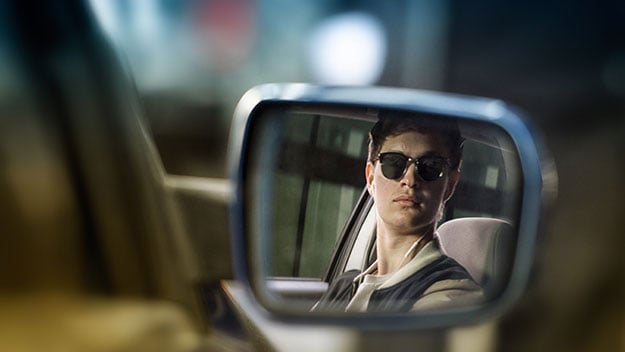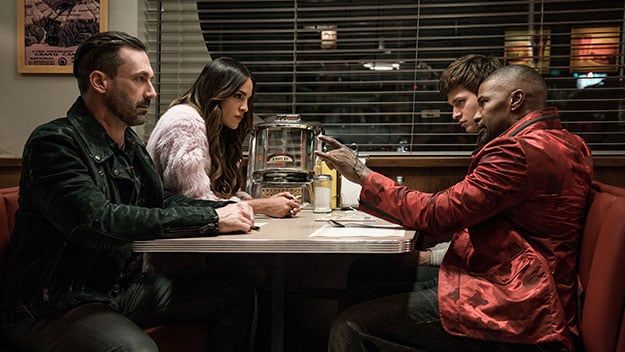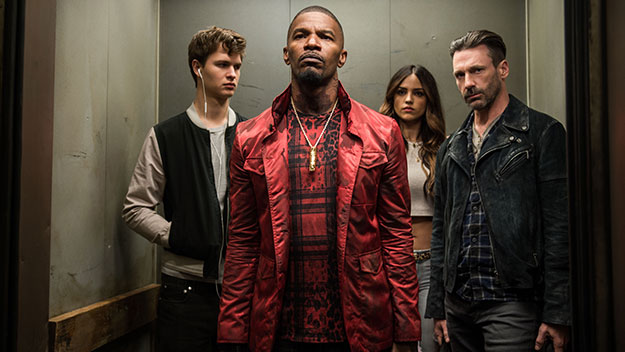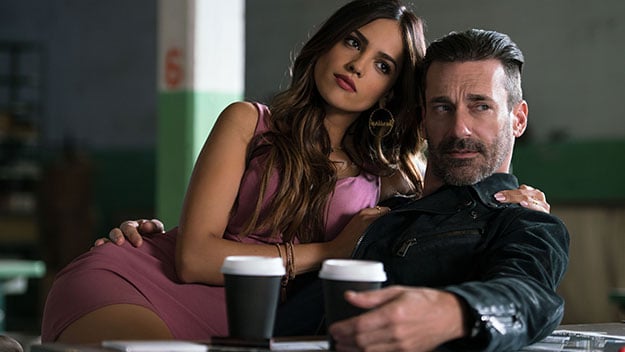In Baby Driver, Edgar Wright drapes the bare-bones structure of crime movies like Jean-Pierre Melville’s Le Samourai or Walter Hill’s The Driver with a pop-aesthetic coat of many colors. Merging his extravagant audiovisual appetite (Shaun of the Dead, Hot Fuzz) to the laconic style and improbable virtue of strong, silent anti-heroes from the movie past, he emerges with an entertaining hybrid. At its best, it affects us like adrenaline mixed with laughing gas. But when Baby Driver, like the Energizer bunny, keeps going and going and going (as with half of Wright’s other films, it’s 20 minutes too long), it manages to run on fumes. A film as gleefully externalized as this one should unfold as an uninterrupted joyride, with one ingenious gimmick locking slickly and solidly into another. And for a while, Baby Driver does just that. In its most remarkable feature, the virtuoso, baby-faced getaway man, Baby (Ansel Elgort), uses rock and pop to fuel his life. The tunes wafting off his array of iPods serve, at different times, as his starter’s pistol, his metronome, his stopwatch, or his heartbeat. The movie is at its witty, pulse-accelerating peak when he must re-set a music track to the beginning before he puts his pedal to the metal. Set and filmed in Atlanta, the core story is as minimalist and easy-to-read as a 1950 crime-fighting comic book. Baby reckons he’s one junked jalopy away from working off a debt to a criminal mastermind named Doc (Kevin Spacey). And just when he thinks he’s out, Doc pulls him back in. (Presumably his name refers to Steve McQueen in The Getaway and Sam Jaffe in The Asphalt Jungle.) Everything else is as spangled as a movie like The Driver is simple and clean. Doc, for example, never employs the exact same heist team twice, which gives Wright the chance to keep introducing and eliminating colorful supporting grotesques. The key crew are the gaudiest gang members. The standout is the genuinely scary Jamie Foxx as a functioning psychopath, Bats, whose string of personal anecdotes invariably ends with someone dead. Jon Hamm and Eiza Gonzalez play a former Wall Street trader, Buddy, and his sexpot mistress, Darling, a pair of Looney Tunes lovebirds who are cold-blooded sociopaths. Initially, at least, they play off each other with an infectious sexual rapport.
Unlike Melville or Hill, Wright gives his hero a home life, with a deaf, wheelchair-bound foster father, Joe (CJ Jones), and his one-and-only true love, an ultra-likable waitress-waif named Debora (Lily James) who enjoys singing while she works. Baby gets a hell of a back-story, too. When he was just a tyke in the rear seat of the family car, it barreled into a crash while Mom and Dad were arguing. The accident was fatal to them and traumatic to him. It saddled Baby with a lifelong case of tinnitus—or as Doc puts it, a “hum in the drum.” Flooding his brain with music drowns it out. Wright renders the calamity in an action-packed flashback, and sprinkles in occasional cuts to establish Baby’s mother as a tender parent and his favorite singer. (Yes, music-love is in the genes.) Rarely has such a heavy psychic load received such a sprightly dramatization. Yet the film is at its most seductive when Wright builds small pockets of mystery into the headlong action: we never stop wondering where the effects of Baby’s trauma end and his genius for music and movement begins. At a recent director-hosted preview in Century City, Wright related the by-now-familiar story of how Baby Driver took root. At age 21, he envisioned a car chase unfolding to “Bellbottoms” by the Jon Spencer Blues Explosion. He then told the audience a cautionary tale about a fellow at a previous screening taking a bathroom break and missing part of the opening chase, which is, indeed, scored to “Bellbottoms.” That first bout of scorched rubber is not as much of a killer sequence as Wright supposes. Baby’s dazzling red Subaru WRX certainly looks marvelous, and there’s one super gag when Wright presents that garish rig in triplicate. But this introduction is conceived to show what happens when a job goes off like clockwork—and that’s an insurmountable problem. As Wright’s editor, Paul Machliss, explains in the current CinemaEditor: “There’s a lot of action that happens to fall on the beats. Now that becomes a big challenge because you want to try and make that happen, and actually have things fall on the beat, but you don’t want it to look clinical and choreographed.” Clearly, Wright and Machliss (and another editor, Jonathan Ames) have isolated the challenge, but I don’t think they always rise to it. Each screeching stunt packs a momentary punch, but overall, the sequence looks too much like a skillfully executed routine. The movie’s pinnacle comes not at the beginning, or at the climax, but in the middle, when the getaways first start to go wrong: the screw-ups generate visceral and comedic power. And the film eventually runs out of its aesthetic-daredevil moves.
But once we glom onto Wright’s ambition to warm as well as pound our hearts, the movie develops its own kind of comic-book suspense. How will Baby survive his forced collaborations with increasingly volatile heist artists—with his core of decency intact? How will Wright maneuver his way toward a happy ending? As long as Wright comes up with new directorial feints and spins, the film registers as a caffeinated daydream. In an early high point, when the opening ride is done, Baby goes on foot to get the gang its coffee at a shop called Octane, and Wright turns his little quest into street ballet. (Locations like Octane and a restaurant called Bacchanalia are real Atlanta sites.) Elgort boasts the perfect blend of grace and offhand goofiness to bring off a pas de deux with the camera as well as a kinetic response to fellow pedestrians as he moves to “The Harlem Shuffle,” which is playing in his head. Wright even makes it work that Baby’s replacement dad can’t hear him. Sign language becomes another choreographic tool. Jones is a warm, magnetic performer. He turns Joe placing his hand over a speaker, to feel the rhythm of Baby’s favorite music, into the film’s most genuine human gesture. (Later, in a courtroom scene, Walter Hill makes an audio cameo as Joe’s interpreter.) Partly because of Lily James’s effervescent ability to embody unspoiled, youthful grace, Baby’s first scene with Debora has an easy charm. She likes his name because, unlike Debora’s, there are tons of songs with “Baby” in the title. But we don’t learn anything more about her as the film goes on. Their relationship becomes a source of jeopardy on the one hand and blue-sky fantasy on the other. It fails to build. And Baby Driver is too eager to please; there’s something oddly ingratiating even when it reverts to hard-guy brutality. It’s as if, in his own scampish way, Wright hopes to please every quadrant of the action-movie audience.
What saves it all from crashing and burning is Wright’s essential exuberance—and Elgort’s. In The Fault in Our Stars he had an offhand theatricality that suited the boy-hero’s sometimes ironic, always idealistic distance from daily life, as well as his love for metaphor. In Baby Driver, Elgort’s theatricality is blissfully upfront. Whether he’s dancing through the streets or mixing recorded scraps of conversation into his own collage-like music, he manages to be stylized without being artificial. Spacey’s performance can’t compare—it’s studied and juiceless, as if he knows he’s played cynical Mr. Wizards once too often. Hamm’s act grows increasingly exaggerated. They’re both disadvantaged by operating in a vacuum. Wright is a gifted pop burlesque artist who can’t always separate his impulse to lampoon genre movies from his yen to recreate them. His parody movies are almost always fun to watch, but when you look back at them, they’re sometimes less thrilling or funny than the movies they poke fun at. (Philip Kaufman’s 1978 Invasion of the Body Snatchers, itself a remake of Don Siegel’s sober 1956 original, is infinitely wittier and scarier than Wright’s 2013 apocalypse, The World’s End.) Working with more of a straight face in Baby Driver, Wright aims for, as he puts it, “something spikier, that harkens back to films like Point Break and The Getaway and the work of Walter Hill. When the action kicks in, it starts to get more frantic and violent. There’s real collateral damage.” Except, in this case, the real collateral damage is to our highest hopes. Michael Sragow is a contributing editor to Film Comment and writes its Deep Focus column. He is a member of the National Society of Film Critics and the Los Angeles Film Critics Association. He also curates “The Moviegoer” at the Library of America website.



